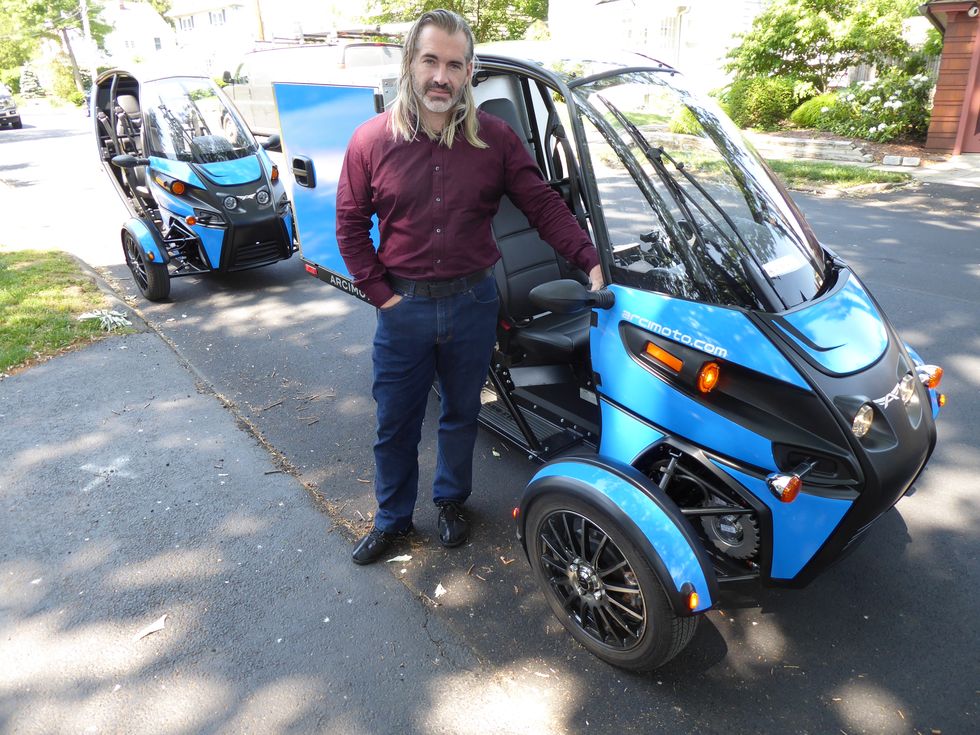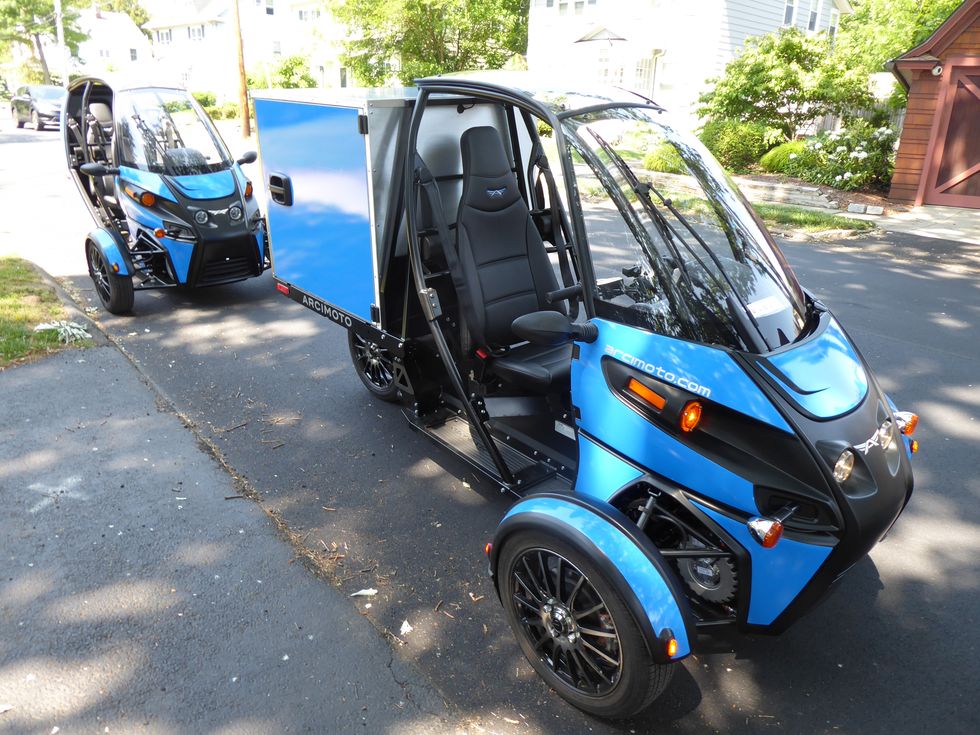- Eugene, Oregon-based Arcimoto makes two-seat, street-legal—and even highway-capable—runabout electric “autocycles” that start under $20,000.
- “People deserve something they can afford. And we have three times the efficiency of a Tesla,” says the Arcimoto CEO.
- Arcimoto first showed its wares at the New York Auto Show in 2018 and had targeted a production of 10,000 vehicles per year. It has sold 600 to date but is still targeting EV-interested entry-level buyers.
Looking for a $20,000 electric car, and finding them thin on the ground? Well, how about a two-passenger, three-wheel Arcimoto FUV? It might not actually meet your conception of “car”—reminding you instead of an Asian tuk-tuk. But it is at least semi-enclosed transportation for two with 105-mile range, twin electric motors (on the front axle) adding up to 37 kilowatts and 77 horsepower, and, well, heated seats and Bluetooth. The packs, which the company builds from Chinese-made pouch cells, total 19.2 kilowatt-hours.
Arcimoto, based in Eugene, Oregon, has been around since 2007, and went public in 2017. It has, to date, sold around 600 vehicles, says new CEO Chris Dawson, who was a senior manufacturing equipment engineer and maintenance manager at Tesla until 2019.
“You don’t need a 6000-pound vehicle to pick up your latte,” Dawson told Autoweek. “Ninety percent of drives in America are for one or two passengers with minimal cargo. The average trip is only three miles, and the daily average is 35 miles.” The Arcimoto FUV, the passenger vehicle, sells for $20,000 and weighs a mere 1300 pounds. A second version, the MUV, adds a sheet-metal box for last-mile deliveries in place of the second seat and sells for $25,000. Calling it a “box truck” might be a stretch, but it can carry 25 cubic feet of goods. There are also utility and carrier packages.
Arcimotos are registered as autocycles, which means they don’t have to be crash tested or include airbags. Safety equipment on board consists of a pair of seatbelts and a substantial roll cage. According to UShip.com, “Technically, autocycles do not fall into the same category as three-wheel motorcycles because the rider is not straddling the vehicle or using handlebars to maneuver it; instead they are sitting in a seat and steering with a wheel. However, autocycles do share some characteristics with motorcycles in that they have less than four wheels and many models feature exposed cabs, hence why helmets are required in some states.”
Actually, these autocycles do have handlebars, but other aspects such as the semi-enclosed bodywork and foot brake are carlike. The two-seat version is aimed at commuters and first-time EV owners. “Most people who work for a living can’t afford today’s electric cars,” said Dawson. “People deserve something they can afford. And we have three times the efficiency of a Tesla.” The Arcimotos are not currently eligible for federal income tax credits, but the company is working on that.
Both types of Arcimoto, with box and second seat, were sampled on the road. Taken on errands to a busy highway near this author’s Fairfield, Connecticut, home, the Arcimoto took some minor acclimatization. The twist-grip accelerator would have required a steeper learning curve, but for the owner of several e-bikes it was a snap. The brake pedal is approximately where the driver expects it to be, but making it larger would probably be a good idea. A secondary brake control uses regen power and is handlebar-mounted.
There’s plenty of power, and the Arcimoto keeps up with traffic easily. The ride is on the rough side of firm, and broken pavement makes it fairly jarring. But visibility is, as you might expect, excellent. The screen is readable in bright sunlight, and the speakers, connected via Bluetooth to the driver’s smart phone (which is given a built-in holder), quite audible. Connecting via Apple Car Play or Android Auto is beyond this simple, low-cost set-up. The turn signals are not self-canceling. There’s a movable cupholder.
Although the Arcimoto is highway-capable, taking that step without doors requires a braver journalist. Half doors are an option ($2500), however, as are some kind of weather-protection side curtains.
When founder Mark Frohnmayer was still in charge (he’s now on the board), Arcimoto showed up at the 2018 New York International Auto Show with early versions of the vehicle now offered (plus promotional t-shirts and socks!). The company was then envisioning a 70-mile base range (and 130 miles with a larger battery for $3000 more). Production of 10,000 vehicles per year priced at just $11,900 to start, was planned.
Obviously, Arcimoto didn’t hit that production milestone. But it’s still pursuing the entry-level EV market, and looking for some commercial customers as well. Has it found its moment?
Contributing Editor
Jim Motavalli is an auto writer and author (nine books) who contributes to Autoweek and Barron’s Penta. He has written two books on electric cars, Forward Drive (2000) and High Voltage (2010), and hosts the Plugging In podcast.
Motavalli’s writing has appeared in the New York Times, CBS Moneywatch, Car Talk at NPR, Forbes, US News and World Report, Sierra Magazine, Audubon, and many more. In his spare time, he reviews books and jazz.




